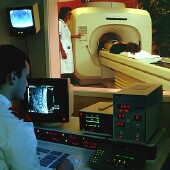
WEDNESDAY, May 9 (HealthDay News) — In an effort to make sure children are not exposed to any more radiation than necessary when they get X-rays or CT scans, the U.S. Food and Drug Administration has asked the makers of these devices to factor in the safety of pediatric patients when using existing machines and designing new ones.
And if the manufacturers of these scanners can’t show their equipment is safe for children, the FDA wants labels on the machines that say so.
The agency released its recommendations on Wednesday, and there will be a four-month period of public comment before the guidelines become final.
X-ray imaging, such as CT scans, conventional X-rays and fluoroscopy, are a valuable way of diagnosing problems and developing treatments, and they can be essential before surgery, the agency noted in a statement.
However, the exposure to ionizing radiation can, over time, raise the risk of cancer, and high doses of radiation may be problematic in children.
“Imaging is very important. It saves lives,” said Dr. Marta Hernanz-Schulman, chair of the American College of Radiology Pediatric Imaging Commission and a professor of radiology and pediatrics at Monroe Carell Jr. Children’s Hospital at Vanderbilt in Nashville, Tenn. “Like any tool, it needs to be used judicially; like any other tool, it’s not a panacea.”
“Children are not little adults,” Hernanz-Schulman added. “Their bodies are more sensitive to radiation, because they are growing, so when the cells are dividing they are more sensitive to the effects of radiation.”
In addition, children actually absorb more radiation when they are given adult doses, she added.
“Most of the effects of radiation are felt decades down the line,” Hernanz-Schulman said.
The cancer risk of ionizing radiation is higher for children than adults, and since the effects of radiation are cumulative children have a longer time for the effects of radiation to show up, the FDA noted in its statement.
Also, X-ray equipment settings designed for adults can cause a larger radiation dose than needed to produce an image in children, the agency added.
“The FDA is giving guidelines to manufacturers who are very interested in doing the right thing and providing people with what we need,” Hernanz-Schulman said.
Getting the manufacturers to make devices that can be easily adjusted for children is a good thing. In addition, the manufacturers need to be available to educate doctors on how to use the equipment for children, Hernanz-Schulman said.
“The risk from a medically necessary imaging exam is quite small when compared to the benefit of accurate diagnosis or intervention. There is no reason for patients who need these exams to avoid them,” Dr. Jeffrey Shuren, director of FDA’s Center for Devices and Radiological Health, said in the statement. “Parents should engage in a discussion with their child’s physician about benefits and risks of X-ray, computed tomography (CT) and fluoroscopy exams.”
Parents should ask their doctor if the procedure is necessary or whether there are different tests that can get the same information without radiation, such as ultrasound or an MRI, Hernanz-Schulman explained.
In addition, parents need to keep track of the tests done and the radiation levels used so they can show doctors when tests are recommended and when their child is seen at different facilities, she said.
The American College of Radiology recommends that parents ask their pediatrician or other provider who orders a scan the following questions:
- How will the scan improve my child’s care?
- Are there alternatives that don’t use radiation?
- Is the facility accredited by the American College of Radiology?
- Will the radiation dose be “child-sized”?
The Medical Imaging & Technology Alliance (MITA) applauded the FDA proposal.
“MITA is proud to be a long-time collaborative partner with the FDA on initiatives to ensure the safe and effective use of medical imaging equipment,” the association said in a statement Wednesday. “Our efforts have included contributing to the development of pediatric radiation safety training materials and convening stakeholders to explore ways to prevent medical errors that involve radiation. MITA looks forward to providing comments on the guidance released today to help reduce unnecessary radiation exposure for children.”
More information
For more on imaging tests, visit the U.S. National Library of Medicine.

